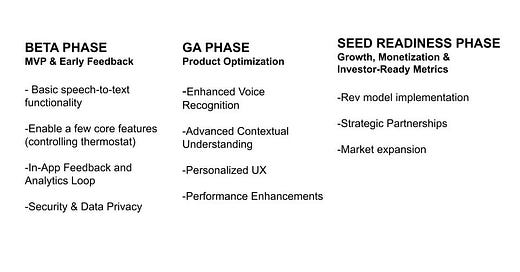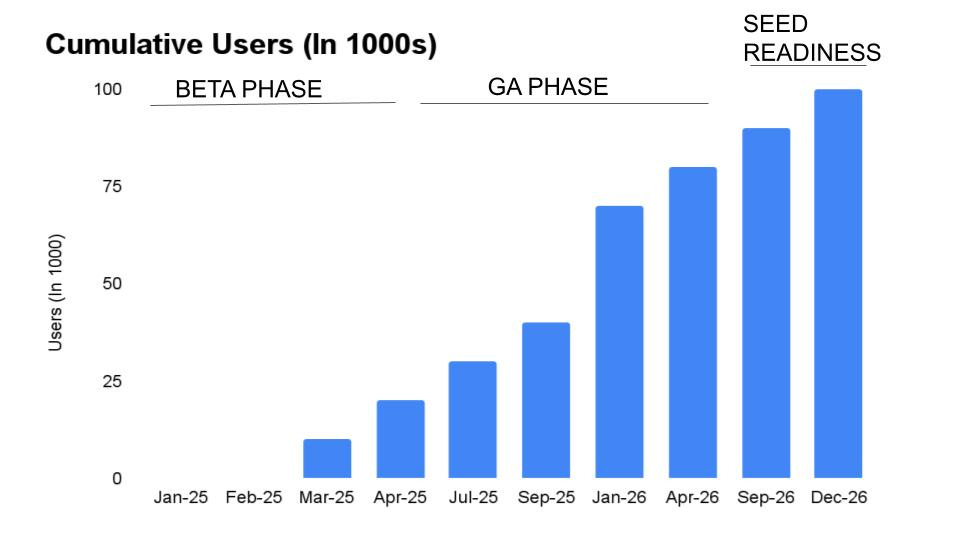From Vision to Investment: Crafting a Product Roadmap That Wow VCs giving your 1st check
A strong product roadmap is one of the important tools an early-stage founder can use to communicate their vision and attract investment. It communicates your vision, strategy, and ability to execute. For early-stage founders, especially those seeking funding, a compelling roadmap is one of the most powerful tools to attract investment.
Yet, I’ve seen too many pitches where founders have an amazing vision, team and customer feedback, and don’t have a strong roadmap or a clear plan to monetize. While we know roadmaps change and founders pivot, presenting a solid execution plan for the next 18–24 months is critical. It shows that you’ve thought through your strategy and milestones, giving investors confidence in your ability to deliver.
Here’s how you can build a roadmap that resonates with VCs and gets you closer to that first check.
Why Your Product Roadmap Matters to VCs
We all know that early stage VCs don’t invest in ideas, and they invest in teams and their ability to execute. Early stage investing most of the time does not involve any traction numbers and what get really crucial is your product roadmap and the GTM strategy. A strong roadmap is a blueprint of the founders vision and strategy but with a clear communication on execution of it. There are so many books written on how to build an effective roadmap, but having read them, they seem to be good tools for late stage start ups.
A compelling product roadmap gives VCs confidence in your:
Strategic Vision: Does your roadmap align with a well-defined problem and how you plan to achieve that in 18-24 months?
Team: Do you have the team in place to execute it?
Milestone Clarity: Are there clear and achievable goals with an execution plan for each?
Scalability: How does the roadmap demonstrate the product’s growth potential?
Risk Mitigation: Does it address foreseeable challenges and how you’ll overcome them?
Your roadmap isn’t just about what you plan to build, it’s about why and how it drives value for the customer problem you are trying to solve
Common Mistakes I’ve Seen Founders Make
Before we dive into how to create the perfect roadmap, let’s address some common pitfalls. Having reviewed countless pitches, I’ve noticed common pitfalls where the VCs loose their confidence. Here are a few to avoid:
Overloading Features: A roadmap cluttered with features dilutes your strategic focus.
Lacking Milestones: Without clear milestones, it’s hard for VCs to track progress or measure success.
Neglecting Metrics: VCs want to see KPIs tied to each stage of your roadmap. These are not set in stone, but gives confidence to VCs about your thinking and how you think you can measure each of the milestones
Being Too Short-Term: While immediate plans are critical, ignoring scalability raises red flags. Questions that you need to think about are is your roadmap telling a story, about the scale of your vision: how do you plan on monetizing at some point and what channels will help you drive that?
Pro Tip:
Your roadmap should tell a story and that story includes details about your MVP, PMF and how do you plan to monetize before your next round.
Building a Roadmap That Attracts Investors
Follow this step-by-step guide to create a roadmap that resonates with VCs:
1. Start with the Vision
Define the problem your product solves and the value it delivers to customers.
Ensure this vision ties directly to the customer feedback e.g: their interviews, quotes etc.. This shows VCs that you are taking customer feedback into account while laying down your bricks (features in this case)
2. Break It Down by Milestones
Identify key deliverables, such as:
MVP Launch: What features will it include, and what user feedback are you seeking for your features. They don’t have to be on the roadmap but they need to be discussed while you present your roadmap to the VCs
Traction Goals: User acquisition, retention metrics, or revenue targets. How does your roadmap plan to achieve traction goals? This could be as simple as adding a goal for Q1, Q2 etc..
Expansion Phases: Geographic markets, new features, or partnerships. Discuss expansion in later stages of your roadmap, if applicable and this shows to VCs that you are thinking through customers in other geographies or channels
PLG (Product Led Growth): There can be an entire section on this, which I will write another time. Including PLG tactics in your roadmap signals to investors that you’re building a product with growth baked into its DNA. It shifts the focus from relying solely on external marketing tactics to creating a product that naturally scales itself.
While marketing campaigns, ads, and other traditional growth tactics play a significant role in scaling a startup, PLG takes a different approach: leveraging your product itself as the primary driver of user acquisition, retention, and expansion. Incorporating PLG into your roadmap not only demonstrates innovative thinking but also shows that you understand how to create a self-sustaining growth engine.
Include timeframes or phases (Beta, GA etc.) for each milestone (e.g., next 3, 6, 12 months). This seems simple, but a lot of founders forget to do this.
3. Prioritize Features Based on Value
Focus on features that:
This could be building features that focus on just acquiring users in MVP until you reach PMF and the monetize later.
Drive measurable outcomes like customer acquisition or retention at each stage of the roadmap
4. Align with Metrics
Tie each phase of the roadmap to specific KPIs. This does not need to be in the same slide as the Product Roadmap and can be in a separate slide
Monthly Active Users (MAUs) e.g: Beta phase will lead to an increase in MAU
Customer Acquisition Cost (CAC) e.g: CAC coming down by 5% in the GA phase
Retention or churn rates - This is a crucial one, and I’ve seen founders not talk about how they plan to account for churn in their growth plan
Discuss during your presentation, how achieving these metrics will tie to your overall product goal. I’ve seen founders not even discuss monetization, but just focus on retention for MVP
5. Show Scalability
Include plans for:
Feature upgrades or new modules. e.g: Monetization through B2B in the getting ready to seed phase
Scaling operations or expanding to new markets : This is a nice to have
Highlight how additional funding accelerates these initiatives and that could be through hiring additional head count
6. Create a Visual, Easy-to-Digest Format
Example below illustrates this
Use a timeline to map milestones clearly: simpler the better
Avoid overloading with technical details; focus on strategic priorities.
Real-World Example
Building a Voice Agent Product Roadmap: From Vision to Seed Readiness
Below is a roadmap example for launching a voice agent product. It’s structured into three clear phases: Beta, GA, and Seed Readiness.
1. Beta Phase: MVP & Early Feedback
This is where your product journey begins. The Beta Phase is about validating your core idea, identifying early adopters, and building the foundation for future growth.
Core Deliverables:
Basic speech-to-text functionality.
A few core features (e.g., controlling a thermostat) to prove your value proposition.
In-app feedback and analytics to collect user insights and iterate quickly.
Security and data privacy to build trust early on.
Why This Phase Matters: The Beta Phase proves feasibility. By focusing on the essentials, you avoid over engineering and create a product that delivers immediate value to a small but important audience.
2. GA Phase: Product Optimization & Achieving PMF
With validation in hand, the product moves into the General Availability (GA) phase. Here, the focus shifts to optimization, scaling user adoption, and achieving Product-Market Fit (PMF).
Key Milestones:
Enhanced Voice Recognition: Support for multiple accents and contextual understanding.
Advanced NLU: Handle more complex commands and multi-step interactions.
Personalized User Experiences: Create adaptive responses based on user behavior.
Achieving PMF: Build retention, reduce churn, and generate organic growth through referrals.
How to Achieve PMF:
Focus on your core value proposition and double down on features that users love.
Optimize the onboarding experience to reduce friction.
Iterate quickly based on user feedback.
Why PMF Matters: PMF is the tipping point where your product starts to resonate deeply with your target audience. It validates that you’ve built something people love and lays the foundation for scalable growth.
3. Seed Readiness Phase: Growth, Monetization, & Scale
Once PMF is achieved, the focus turns to monetization and preparing for scale. This phase demonstrates your readiness for the next stage of investment.
Key Milestones:
Revenue Model Implementation: Introduce monetization strategies such as subscriptions or tiered pricing.
Strategic Partnerships: Collaborate with third parties to expand your ecosystem.
Market Expansion: Localize your product for new markets and user demographics.
Why This Phase Matters: The Seed Readiness Phase is about scaling intentionally. It shows investors that your product has the potential to generate revenue and sustain long-term growth.
Tracking Traction Through Growth Metrics
The second image shows how each phase contributes to cumulative user growth:
Beta Phase: Modest adoption as the product is tested with early adopters.
GA Phase: User growth accelerates as the product achieves PMF and gains broader appeal.
Seed Readiness Phase: Exponential growth driven by scalability and market expansion.
This trajectory aligns your roadmap with measurable outcomes, which builds momentum for both your team and investors.
Why This Roadmap Structure Works for Founders
Here’s why structuring your roadmap across these phases is crucial for early-stage success:
Focus on What Matters: It prevents scope creep by prioritizing features and milestones that drive real progress.
Build Investor Confidence: A clear roadmap signals that you have a thoughtful plan and the ability to execute.
Accelerate PMF: By aligning with user needs and iterating quickly, you achieve PMF faster, reducing risk.
Create Measurable Wins: Each phase delivers tangible results, building momentum for your team and stakeholders.
Enable Scalable Growth: By laying the right foundation, you ensure your product is ready to scale without breaking.
Bonus: Questions VCs Might Ask About Your Roadmap
How do you plan to use funding to accelerate the roadmap?
What risks could derail your progress, and how will you address them?
What tech capabilities will you build to support the milestones?
Be prepared to answer these questions confidently, as they’ll reinforce the credibility of your plan.
Closing Thoughts
A well-crafted product roadmap is more than a document—it’s a powerful storytelling tool. It communicates your vision, strategy, and ability to execute while giving VCs the confidence to invest in you. By focusing on clarity, metrics, and scalability, you can turn your roadmap into a competitive advantage.






